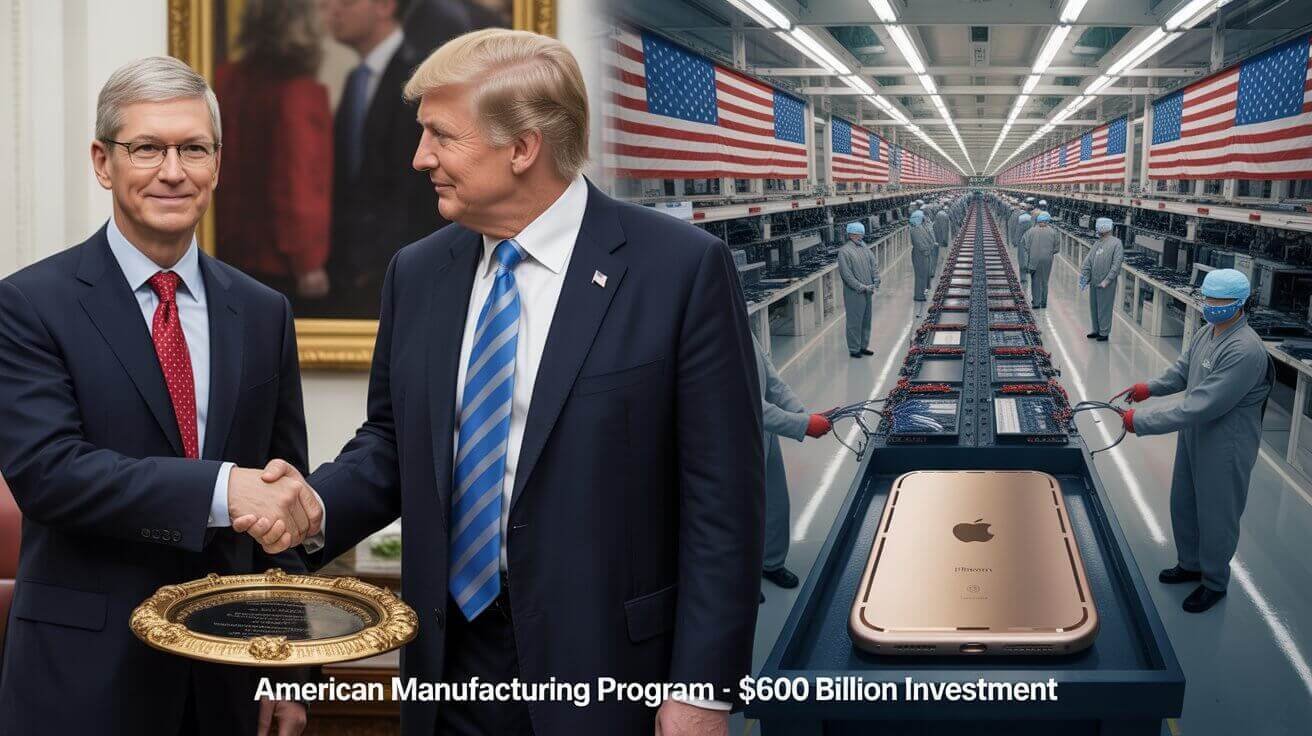I’ll be honest – when I first heard about Apple’s latest announcement, my initial thought was “here we go again with another corporate PR stunt.” But after digging into the details of their new American Manufacturing Program, I’m genuinely surprised by how comprehensive this initiative actually is. We’re not talking about Tim Cook making vague promises in a boardroom. This is a concrete $600 billion commitment that could fundamentally reshape how tech products get made in America.
The timing couldn’t be more perfect, either. With Trump back in the White House threatening 25% tariffs on foreign-made goods, Apple just made a move that’s equal parts strategic genius and necessary survival. Their American Manufacturing Program isn’t just about avoiding tariffs – it’s about building something unprecedented: a complete end-to-end tech supply chain on American soil.
But here’s what really caught my attention: this isn’t just Apple throwing money around to look good. They’re actually partnering with nine major suppliers to create an integrated manufacturing ecosystem that could produce 19 billion chips for Apple products in 2025 alone. That’s the kind of scale that changes entire industries.
What’s Really Behind Apple’s American Manufacturing Program Strategy
The $100 Billion Acceleration That Caught Everyone Off Guard
Let me paint the full picture here. Earlier this year, Apple announced a $500 billion investment in US manufacturing over four years. That seemed substantial enough. Then, in a surprise White House announcement with President Trump, Tim Cook added another $100 billion to the pot, bringing the total to $600 billion.
This American Manufacturing Program expansion happened fast – almost like Apple knew something the rest of us didn’t. And maybe they did. With Trump’s recent threats to impose 25% tariffs on imports, including a specific mention of iPhones made outside the US, Apple’s timing looks less coincidental and more calculated.
The beauty of this strategy is how it addresses multiple problems simultaneously. Apple avoids potential tariffs, strengthens supply chain resilience, and gets favorable treatment from an administration that’s been critical of their overseas manufacturing. It’s corporate chess at its finest.
Nine Partners, One Vision: Building America’s Tech Manufacturing Future
The American Manufacturing Program isn’t a solo venture. Apple has assembled an impressive coalition of partners that reads like a who’s who of American tech manufacturing:
- Corning (Kentucky) – Will produce 100% of iPhone and Apple Watch cover glass in the US
- Texas Instruments (Utah and Texas) – Advanced semiconductor manufacturing
- TSMC (Arizona) – Cutting-edge chip fabrication using the most advanced processes in America
- Applied Materials (Texas) – Semiconductor manufacturing equipment
- GlobalWafers America – Silicon wafer production
- Broadcom, Samsung, GlobalFoundries – Various chip technologies
- Amkor (Arizona) – Chip packaging and testing
- Coherent (Texas) – VCSEL lasers for Face ID and other features
What’s remarkable about this list is how it covers every aspect of modern electronics manufacturing. From raw silicon wafers to finished components, Apple is creating a supply chain that doesn’t need to leave American soil.
How the American Manufacturing Program Reshapes Global Supply Chains
From China-Dependent to America-First: The Massive Shift
Here’s something that might shock you: according to research from the American Enterprise Institute, Apple’s dependence on China has actually grown over the past decade. While they used to rely on China primarily for final assembly, now Apple sources many high-value components from Chinese suppliers too.
The American Manufacturing Program flips this dynamic entirely. Instead of depending on a single country thousands of miles away, Apple is creating redundancy and resilience through domestic production. This isn’t just about reducing risk – it’s about gaining competitive advantages.
Consider the logistics alone. When Apple needs to make last-minute design changes or ramp up production quickly, having suppliers in Kentucky, Texas, and Arizona instead of Shenzhen makes a massive difference. We’re talking about days versus weeks for supply chain adjustments.
The Ripple Effects Across American Manufacturing
But the American Manufacturing Program impact extends far beyond Apple’s immediate needs. According to industry analysis, this kind of large-scale tech manufacturing investment creates what economists call a “multiplier effect.”
Every direct job Apple creates typically supports 2-3 additional jobs in related industries. We’re talking about logistics companies, component suppliers, equipment manufacturers, and service providers. When you’re dealing with a $600 billion investment over four years, the economic ripple effects are enormous.
And here’s what excites me most: this could inspire other tech companies to follow suit. Apple isn’t just reshoring their own manufacturing – they’re proving it can be done profitably at scale. That’s a powerful demonstration for the entire industry.
Breaking Down the Economic Impact and Job Creation
Real Numbers, Real Jobs: What $600 Billion Actually Means
Let’s get specific about what this American Manufacturing Program investment translates to in practical terms. Apple says they’ll create 20,000 direct jobs over the next four years, but that’s just the beginning.
The Corning partnership alone involves a $2.5 billion expansion in Kentucky that will make that facility the world’s largest smartphone glass production line. According to Bloomberg’s reporting, this isn’t just about jobs – it’s about bringing cutting-edge manufacturing capabilities to American soil.
Texas Instruments is expanding facilities in Utah and Texas with Apple’s support. TSMC’s Arizona fab, where Apple is the first and largest customer, employs over 2,000 workers manufacturing chips using the most advanced process technology in America. These aren’t assembly-line jobs – these are high-skilled, high-paying positions in advanced manufacturing.
The Training and Education Component That Changes Everything
Here’s something I didn’t expect: the American Manufacturing Program includes a significant education component. Apple is opening a Manufacturing Academy in Detroit later this month, specifically designed to train workers for small and medium-sized US manufacturers.
This addresses one of the biggest challenges in American manufacturing: the skills gap. You can’t just flip a switch and have thousands of trained workers ready for advanced semiconductor manufacturing. Apple is investing in creating that workforce, which benefits the entire industry.
They’re also providing training and education programs that have reached more than 8 million people since 2008. That’s not just corporate social responsibility – that’s building the human infrastructure needed to support advanced manufacturing at scale.
Supply Chain Resilience: Lessons from Recent Global Disruptions
The Pandemic Wake-Up Call
The COVID-19 pandemic exposed how fragile global supply chains really are. When factories in China shut down, tech companies worldwide scrambled to find alternatives. Apple wasn’t immune to these disruptions, despite their supply chain expertise.
The American Manufacturing Program directly addresses these vulnerabilities. By creating domestic production capabilities for critical components, Apple reduces their exposure to future global disruptions. Whether it’s pandemics, natural disasters, or geopolitical tensions, having manufacturing capabilities closer to home provides crucial resilience.
But there’s another angle here that’s often overlooked: quality control. When your suppliers are in the same time zone and accessible by car rather than international flights, it’s much easier to maintain the exacting quality standards Apple is known for.
Geopolitical Hedge Against Uncertainty
Let’s talk about the elephant in the room: US-China relations. Trade tensions have been escalating for years, and they’re not going away anytime soon. According to supply chain experts, the companies that thrive in this environment are those that build geographical diversification into their operations.
The American Manufacturing Program gives Apple exactly that kind of diversification. They’re not abandoning international manufacturing entirely, but they’re creating alternatives that reduce their dependence on any single country or region.
This is particularly smart given the current political climate. Trump has made “Made in America” a cornerstone of his economic policy, and Apple’s domestic investment aligns perfectly with those priorities. It’s good politics that happens to also be good business.
Future Implications: What This Means for Tech Manufacturing
The Technology Transfer Effect
One of the most interesting aspects of the American Manufacturing Program is how it brings cutting-edge manufacturing technology to American soil. TSMC’s Arizona facility, for example, uses some of the most advanced semiconductor manufacturing processes in the world.
This technology transfer effect could be transformative for American manufacturing competitiveness. When world-class facilities and processes are established in the US, they create opportunities for innovation and improvement that benefit the entire ecosystem.
I’m particularly excited about Apple’s partnership with Applied Materials in Austin, Texas. Applied Materials makes the equipment that other companies use to manufacture semiconductors. By expanding their US operations, Apple is strengthening the entire semiconductor manufacturing supply chain.
The Competitive Advantage of Domestic Innovation
Here’s something that might not be obvious: manufacturing and innovation are more connected than most people realize. When your design teams and manufacturing facilities are in close proximity, you can iterate faster and bring new products to market more quickly.
The American Manufacturing Program creates these kinds of innovation clusters. The Apple-Corning Innovation Center in Kentucky, for example, will focus on developing next-generation materials and manufacturing platforms. This isn’t just about making existing products in America – it’s about inventing the future of manufacturing.
Setting the Stage for Industry Transformation
I believe Apple’s American Manufacturing Program will be studied as a turning point in tech manufacturing. The scale and comprehensiveness of this initiative proves that high-tech manufacturing can be profitable in the United States, even for consumer electronics.
Other tech companies are already taking notice. According to Fortune’s reporting, executives across the industry are watching Apple’s approach as a potential model for navigating the new political and economic landscape.
If Apple succeeds in creating a profitable, scalable domestic manufacturing operation, it could trigger a broader reshoring movement across the tech industry. The ripple effects of that would be enormous for American manufacturing and the broader economy.
The Bottom Line: Real Change or Expensive PR?
After analyzing all the details, I’m convinced this American Manufacturing Program represents genuine change rather than just expensive public relations. The scale of investment, the breadth of partnerships, and the specificity of the commitments all point to a serious, long-term strategy.
But let’s be realistic about the challenges. Reshoring manufacturing at this scale is incredibly complex and expensive. There will be delays, cost overruns, and technical challenges along the way. The question isn’t whether Apple will face obstacles – it’s how well they’ll navigate them.
What gives me confidence is Apple’s track record in supply chain management. They didn’t become the world’s most valuable company by accident. If anyone can pull off a manufacturing transformation of this magnitude, it’s probably them.
The American Manufacturing Program also addresses one of the biggest criticisms of previous reshoring efforts: sustainability. This isn’t a temporary response to political pressure – it’s a multi-year, multi-billion dollar commitment that creates lasting infrastructure and capabilities.
Whether you’re an Apple investor, a manufacturing professional, or just someone interested in American economic policy, this American Manufacturing Program deserves your attention. We’re witnessing the beginning of what could be a fundamental shift in how high-tech products get made, and Apple is leading the charge.
The next few years will tell us whether this bold bet pays off, but one thing is certain: American manufacturing just got a lot more interesting.








